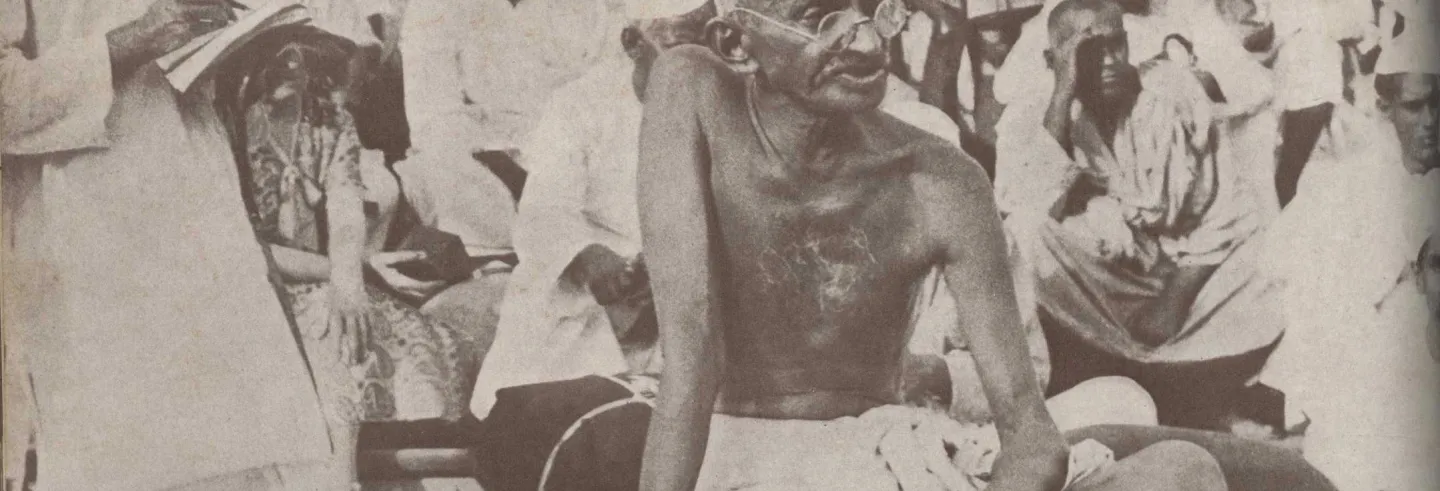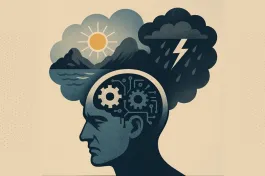On 10 March 1922, Mohandas Karamchand Gandhi was arrested on the charge of sedition. In a routine form filled before the prison administration, he gave his profession as a "farmer and a weaver."
This small yet significant change in Gandhi’s self-description is often absent from the accounts of the Great Trial of Ahmedabad. Several years earlier, on 14 April 1916, in an application for the enrolment as a life-member of the Gujarat Vernacular Society, he had described himself as a "teacher living on my own labour," and gave his monthly pay as less than Rs 30. 1 The rules of the society allowed for payment of concessional fee of Rs 25 as against the regular fees of Rs 50 for women and teachers with pay of less than Rs 25. The society returned the fee and appointed him as an honorary life member. Collected Works of Mahatma Gandhi 13: 267.
Between these two bureaucratic form filling acts lies the story of not only Gandhi’s journey of self-perception but also a philosophical movement that sought a new understanding of work and its relationship with freedom.
Gandhi was called to the bar and practised law actively at least till 1911. It was only after 1922 that he was formally debarred by the Inns of Court. Being an attorney was central to his life, work, and self-perception while he was in South Africa till 1915. Even when he stopped his legal practice and gave up his chambers, he did not cease to be an ‘advocate’.
There was nothing in Gandhi’s social, economic, cultural, or educational background that would have made him sensitive to bodily labour.
This change in Gandhi’s self-perception has been explained either biographically or as a response to a specific context of a political situation. It is very often captured by a sartorial change. On 21 December 1913, Gandhi gave up what from September 1888 had been his favoured style of clothing — which can only be described as clothes befitting an England-trained barrister — and adopted the clothes of the indentured labourer: a veshti and a short kurta. When he returned to India in 1915, this gave way to the attire of a Kathiawadi peasant and remained so with some modification till 21 September 1921, when he adopted the short-dhoti and bare-chest attire with which he is most associated.
While the politics of clothing and their symbolic meaning are necessary to understand Gandhi’s evolving relationship with clothing and his greater and deeper identification with the Daridra Narayana, the poor as god, we need to separately consider Gandhi’s evolving understanding of work and bodily labour — and for that reason the body itself.
There was nothing in Gandhi’s social, economic, cultural, or educational background that would have made him sensitive to bodily labour. For generations, the Gandhi family had been administrators, Dewans of various principalities in Saurashtra. In no autobiographical account by Gandhi or the vast biographical literature on him, is there a mention of the Gandhis being a land-owning family and engaged in agricultural activity even as absentee landlords. The absence of land owning is significant, especially in the feudal political economy to which the Gandhis belonged. Land grants were common in feudal principalities, especially to the highest administrative officer, the Dewan.
There are also clear indications that the Gandhi family both in Porbandar and at Rajkot had domestic ‘servants’, as befitting their administrative, cultural, and economic status. Thus, Gandhi’s early socialisation did not make him empathetic to bodily labour, except that which is rendered to elders as seva, service.
Gandhi’s recollections of his adolescent self also show a marked proclivity to avoiding physical exercise, which he did only under duress even at school. The only time that he was attracted to building the physical abilities of a stout body that was capable of running fast and jumping high and long was when he convinced himself, with the aid of his friend Sheikh Mehtab, that meat eating was necessary to drive away the British from India.
It was a student in England that Gandhi came to be deeply attached to a lifelong passion: walking. The act of walking is central to Gandhi’s imagination, his politics and his self-practice. But the act of walking, either as politics, or as penance for the maintenance of the body’s constitution, or as prayer, is not the same as work done through hands.
His stay in London as a student and later in South Africa without Kasturba and their sons, taught Gandhi valuable lessons in self-reliance. His parsimonious nature, frugality, and racial discrimination made him self-reliant. Gandhi not only learnt to shave himself — the acquisition of this skill was important enough to be noted by him — but also cut his own hair in racial South Africa, happily participating in the mirth that it gave rise to. He dispensed with the regular services of a washing company and learnt to wash and starch his barrister’s collars and cuffs. He tried his hand at cooking. (Despite his growing ‘food-faddism’, he remained an indifferent cook and preferred to eat in vegetarian restaurants as a regular customer, even investing monetarily in them to make them solvent.)
Gandhi, by becoming a nurse, had overcome a deep cultural bias of his Vaishnava family, both of touch that pollutes and a diseased body.
Gandhi during his stay in South Africa also became an expert ‘nurse’. The paucity — or near absence — of trained doctors and nurses for persons of colour and indentured labourers was the catalyst for the acquisition of this ability. As a young person in Rajkot thinking of a future in England, he had considered a life as a doctor, but cultural taboos and apprehensions precluded that possibility. But in South Africa, Gandhi found his calling as a nurse and could do ‘concrete’ service to fellow human beings.
When a person with leprosy came to his door Gandhi had no heart to send him off with just a meal. Gandhi gave him shelter, treated his wounds and looked after him before admitting him to a government hospital for indentured labourers. Gandhi trained himself as a nurse under Dr. Booth and learnt to dispense medicines as a compounder. This early training and passion was to make him an extraordinary ‘quack’, "an unta vaidya’" in his words. Gandhi, by becoming a nurse, had overcome a deep cultural bias of his Vaishnava family, both of touch that pollutes and of a diseased body. Gandhi was to venture into potentially hazardous terrain for himself and more so for Kasturba and their unborn child. On 22 May 1900, in their Durban house, Gandhi acted as obstetrician-on-duty and delivered Kasturba of their last offspring, Devadas.
It was in South Africa that Gandhi overcame what would have been a deeply held prejudice in all caste Hindus: cleaning human excreta. Gandhi adopted the practice of cleaning both the night soil and chamber pots not only used by him but by those who stayed in his house. In his autobiography he records with deep pain, anguish, penance, and some embarrassment the incident involving Kasturba, when he forced her under great duress and with the coercive zeal of a reformer to clean chamber pots for their house guests.
Those ‘transgressions’ prepared him to think about bodily work from a different philosophical and political ground.
Henry Solomon Leon Polak (1882-1959) holds an abiding place in Gandhi's career as the person who introduced him to Ruskin's Unto This Last, a book, which as Gandhi himself has said, altered the course of his life and his ideas towards bodily labour. Polak, born in a Jewish family in Dover, England, went over to South Africa in 1903 for a health cure. After working as a journalist in The Transvaal Critic at Johannesburg, he joined Gandhi, becoming a close colleague in the cause of Indians' rights in South Africa and one of the leaders of the Indian Passive Resistance Movement. Polak and Gandhi shared a house from 1904 to 1906 at 11, Albermarle Street in Johannesburg. Millie Graham Polak (1881-1962), of Scottish Christian descent joined Polak as his fiancée in December 1905 and they were married with Gandhi acting as a witness. She describes this household in great detail in her biography of Gandhi, but there is no mention of bodily labour.
The family preferred an intellectual discourse as post-dinner conversation. "After dinner, if no strangers were present, we used to sit together whilst Mr. Gandhi or one of his wards intoned a couple of slokas or verse from the Bhagvad Gita, whilst my husband would read the English equivalent from Arnold’s beautiful Song Celestial. Mr. Gandhi explained the difficult passages to us and general discussion followed." (It is tempting to trace the origins of Gandhi’s congregational evening prayer to this family ritual.)
[T]wo significant influences ... helped shape Gandhi’s growing fondness and enthusiasm for working with his hands: one was contact with a community of Trappist monks ...and the other was jail going.
Gandhi has recorded as to how a reading of John Ruskin’s Unto This Last during a train journey changed his life. The establishment of the Phoenix Settlement with its resolve to subsist by each one contributing bodily labour is attributed to the reading of Ruskin. The Phoenix community with its International Printing Press, its journal, the Indian Opinion, and agricultural plots that each settler was to cultivate, sought to become a self-sustaining community devoted to labour and freedom. While Gandhi had felt and practiced this in the private domain (though not without its societal aspects), the move to Phoenix gave him a community of co-practitioners. This community through its thought and practice transformed the ‘settlement’ into one of modern India’s most original and innovative experiment, the ashram.
Apart from the influence of Ruskin’s thought, Gandhi’s deep and lasting friendship with Hermann Kallenbach helped Gandhi to think of ideas of working with hands. Kallenbach, who was introduced to Gandhi by barrister Rahim Karim Khan, was a bricoleur, born in Neustadt, East Prussia in a Jewish family, trained and apprenticed as a mason, carpenter, building technician, and architect. He was also a keen sportsman. Gandhi and Kallenbach shared lodgings at various places, most famously in 1910 in a 1,100-acre property of Kallenbach later named as Tolstoy Farm, where they set up a colony for families of Satyagrahis and others to cultivate self-reliance through carpentry, gardening, sandal making, and austerity.
Jail going in South Africa often came with ‘hard labour’, and hard labour he did...
There were two significant influences that also helped shape Gandhi’s growing fondness and enthusiasm for working with his hands. The first was contact with a community of Trappist monks residing in a monastery atop the Marianne hill outside Durban. The Trappist monks had a deep impact on Gandhi’s striving to create and nurture a community devoted to truth and non-violence, seeking freedom and moksha.
There are two distinct gifts that the Trappist monks gave to Gandhi, two different materials, two different practices, and for that reason, two distinct imaginations. One was sandal making. Gandhi learnt, along with Kallenbach, to make leather sandals. The Trappist sandals in India became the Gandhi Patti Chappals or the Sabarmati Chappals. The other was architectural. The deeply etched memory of the chapel on the Marianne hill and Kallenbach’s carpentry and architectural sensibility is evident in the assembly of beams that Gandhi made for his house Hriday Kunj, on the banks of Sabarmati in Ahmedabad. (The trusses used at Hriday Kunj are technically referred to as King Post Trusses, a closed triangle with a central post and two diagonal splayed struts.)
The second influence was jail going. Jail in South Africa often came with ‘hard labour’, and hard labour Gandhi did. His body was used to frugality, sparseness but not hard labour. The jail experience introduced a change in the life at Phoenix. Food, sleep and work changed fundamentally. ‘Hard’ labour was made obligatory.
Gandhi’s grand-nephew Prabhudas Chhaganlal Gandhi remembers a time when this change was introduced, when he and Gandhi’s youngest son, Devadas, were about 10. Gandhi came to Phoenix from Johannesburg and left having made a profound change in the lives of the settlers. Prabhudas recalls: “The following day Bapuji came to Phoenix for some hours. He gave instructions to my father and Maganlalkaka about Devadaskaka’s studies. Bapuji impressed upon Devadaskaka the need to start on a saltless diet from the next day itself. He paid no heed to the pleas of the elders to make concessions about the saltless diet [...] Moreover, he also gave clear instructions about the necessity of hard bodily labour of digging with a spade to be done every day in the searing heat of afternoon between 2 p.m. and 4 p.m” (Prabhudas Gandhi 1948, 203).
Gandhi was aware that intellectual labour was necessary for the culture of the mind and accepted the necessity of division of labour, but not the idea that bodily labour had to be confined to one class and intellectual labour to another class.
This was also the period when Gandhi was reading with close attention Tolstoy and the Bible. His study of the Gita, which had started in London, had deepened further. He knew of the punishment given to humans to live with the sweat of their brow in the Genesis (3:19). Tolstoy and T.M. Bondoref gave him the idea of ‘Bread Labour’, the obligatory labour to be done by all irrespective of their work. Gandhi’s own reflection on the Gita enriched this idea of Bread Labour. 2 Gandhi coined an evocative phrase in Gujarati for bread labour: anna mehnat.
The Gita speaks of yajna, sacrifice as the basis of creation. The Gita says, "together with sacrifice did the lord of the beings create" (discourse III, verse 10) and from "sacrifice comes rain." (discourse III, verse 14). This sacrifice, this yajna is the result of action. The Gita also advocated the supremacy of desireless, detached action. The question for Gandhi was how was one to cultivate action that was desireless, nishkama.
Gandhi’s response was uniquely his. He argued that any action performed for others— yajna or sacrifice—is desireless action. The intertwining of Bread Labour and sacrificial action gave him the idea of sharirshrama, bodily labour that became integral to his life and also an ashram vow. It is in a letter of 7 November 1921 written to Mahadev Desai that Gandhi explained the relationship:
We must perform the duties arising from the existence of the body. Eating, bathing, going from place to place for begging, ¾ all these we do, thinking them to be legitimate activities, and show aversion only to bread-labour; purification of the mind is advanced by mental yajna, that of the atman by yajna of the atman, and of the body by the yajna of the body [i.e. physical labour]. Man cannot make a proper return for the food he gets for his body by doing mental work. One does yajna [of the body] if one labours without expecting food in return. (CWMG, vol. 21, p. 400)
He was to call upon every Indian to offer sharirshrama as a contribution to the cause of freedom. This for him took the form of spinning, an activity that he termed as sutra yajna, sacrificial spinning. Gandhi was aware that intellectual labour was necessary for the culture of the mind and accepted the necessity of a division of labour, but not the idea that bodily labour had to be confined to one class and intellectual labour to another class. He advocated that voluntary idleness had to go.
As his engagement with the work and yajna deepened, Gandhi began to see bodily labour not only as a basis of trusteeship, but necessary for the natural observation of brahmacharya, conduct that leads one to truth. “If all worked for their bread, distinction of rank would be obliterated; the rich would still be there, but they would deem themselves only trustees of their property and would use it mainly in public interest. Bread labour is a veritable blessing to one who would observe non-violence, worship Truth and make the observance of brahmacharya a natural act” (CWMG, vol. 44, p. 150).
The dignity of labour that he so often spoke about and demanded was predicated upon breaking this relationship between bodily labour, pollution of materiality and ascribed impurity of human beings.
His engagement with the material world was marked by his capacity to think with his hands, engaging with materials to understand them and cultivate a transformative relationship. This engagement allowed him to understand the svabhava, the essence of the materials without the cultural attributes that were ascribed to them. By working with materials he not only sought to transform the material but also himself. He created through this process a new person, deeply modern, seeking to rid himself of the caste Hindu prejudice of being polluted by the material world.
Gandhi’s work with the material world included a wide range of materials and work cultures: printing press (from writing and compositing to working the treadle), carpentry, leather work (tanning to sandal making), agricultural work, sanitation work (both public and private sanitation), spinning, weaving, and dying of textiles.
Gandhi, by choosing to work with all the materials that were considered untouchable and polluting by caste Hindus, was seeking freedom from that prejudice.
Gandhi was aware that just as there was a hierarchy of ritual purity and impurity that formed the basis of the practice of untouchability, a similar and largely intertwined hierarchy was attributed to the material world and to work itself. Gandhi, by choosing to work with all the materials that were considered untouchable and polluting by caste Hindus, was seeking freedom from that prejudice. The dignity of labour that he so often spoke about and demanded was predicated upon breaking this relationship between bodily labour, pollution of materiality and ascribed impurity of human beings.
His desire for this freedom from hierarchy of his birth could only be attempted by work with hands. Hand work had to be given the same significance as thought. In fact, one had to acquire the capacity of a craftsperson to think with her hands to attain this freedom. Work for Gandhi was a path to salvation.










